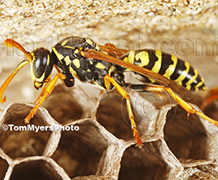Bees and wasps – a look at stinging insects
 One of the most visible and commonly encountered pests of summer is the bee. Or is that a wasp? Is there really a difference?
One of the most visible and commonly encountered pests of summer is the bee. Or is that a wasp? Is there really a difference?
There are more than 1,600 recorded bee species in California. Determining which ones can threaten humans and which ones benefit our ecosystem is not always easy.
The benefits these pollinators offer both agriculture crops and the plants and flowers in our backyards are vitally important. However, according to the National Pest Management Association, stinging insects send more than 500,000 people to emergency rooms annually. And removing a hive or nest is something that you should never attempt to do on your own.
World Bee Day recently occurred on May 20, so Clark, your neighborly pest control, lawn care, and termite control expert, figured it was time to help set the record straight and share some valuable information on stinging insects.
In addition to the experts at Clark Pest Control, we’ve tapped into the researchers and entomologists at the University of California Riverside, who took to Instagram recently to answer homeowner questions about bees and wasps.
What is the difference between bees and wasps?
Wasps and bees are members of the same insect order (Hymenoptera) that also includes ants and sawflies. Wasps can be beneficial – as they are voracious predators of certain plant-destroying insects and flies – but some wasps also are stinging insects. When they, or their nests, are disturbed, that ability to sting repeatedly makes them dangerous (unlike bees, which sting once and then die).
Some wasp species – like yellowjackets, hornets, and paper wasps – are social insects that live in colonies in the way that ants, bees, and termites do; others, like mud daubers, are solitary and do not live in colonies.
The bee is often cited as a symbol of industriousness from the animal kingdom. For the most part, these Hymenopteran insects are of benefit to mankind; they pollinate crops and provide honey. However, certain aggressive species are a threat.
Technically speaking, bees are wasps that have evolved to feed on pollen. The ancestor of all modern bees was, as far as we can tell, a small wasp that fed on thrips, a type of insect, and many thrips eat pollen.
How many species of bees exist, and which is the most aggressive toward humans?
There are over 20,000 species of bees in the world today. Many previously unknown species are discovered every year, but at the same time, several species go extinct, so we can never be certain of the exact number.
No bee species is aggressive toward humans, but there are a small number, including honeybees, that have defensive behaviors, and they will attack almost anything that threatens their nests – including bears, skunks, badgers, raccoons, birds, and humans.
Of all the bees, the defensive responses of honeybees are the most dramatic, and the most life-threatening, so people who work with honeybees need to wear special protective gear.
How can you support local honeybees?
If you live in the U.S., Canada, or Mexico, for example, where honeybees are not native, the only place they should be is in managed colonies under a beekeeper's care.
Honeybees are a domesticated animal used for agricultural purposes. As such, they really shouldn’t be allowed loose into the wild, because – as with any non-native species – they can have negative effects on native ecosystems.
When used to pollinate crops, honeybees serve an important function. But outside of that specific context, they aren't actually good to have around – they consume food that could have been used by native bees and other pollinators, and they help spread invasive weeds that native pollinators aren't pollinating.
So, in the long run, you don't want to have any local honeybees other than the ones being kept by beekeepers.
Native bee species need safe places to live and thrive, so the preservation and protection of wild, native habitats is the thing most essential to their survival.
What plants I can add to my garden to attract bees and provide a home for them?
There are many resources to help you select the best plants for yards and garden to attract a diversity of insect and hummingbird pollinators. These pollinators are looking for nectar and pollen rewards, and fortunately a lot of plant species do well in garden environments.
For California, the bee experts at the University of California Riverside recommended the Xerces Society’s Pollinator Plants and the Pollinator Partnership websites that allow you to enter your ZIP code and get a list of potential pollinator plants that will thrive in your area.
If you have questions about bees and wasps, and which ones are a threat, call California’s trusted, friendly stinging insect control expert, Clark, at (800) WE-NEED-YOU (936-3339) or send an email to clarkcares@clarkpest.com.
Until next time, the pest management professionals at Clark Pest Control thank you for helping to keep unwanted pests out of your home.


